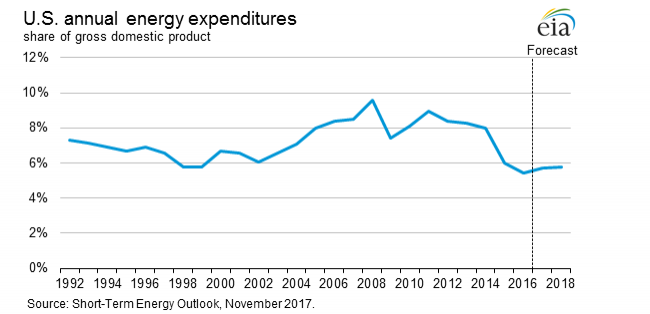
U.S. PETROLEUM DEMAND UP TO 19.9 MBD

API - Total petroleum deliveries in October moved up by 1.1 percent from October 2016 to average 19.9 million barrels per day. These were the highest October deliveries in 10 years, since 2007. Compared with September, total domestic petroleum deliveries, a measure of U.S. petroleum demand, decreased 1.8 percent. For year-to-date, total domestic petroleum deliveries moved up 1.2 percent compared to the same period last year.
"The economy continues to grow as fuel demand remains strong and more people find work," said API Director of Statistics Hazem Arafa. "Unemployment went down last month and gas prices remain relatively low benefiting American businesses and workers."
Gasoline production was up from the prior month, but was down from the prior year and the prior year-to-date. In October, gasoline production reached the second highest output for the month of October, up 3.5 percent from the prior month, but down 0.2 percent from the prior year to average 10.0 million barrels per day in October. For year-to-date, gasoline production decreased 1.5 percent compared to the same period last year and was the second highest year-to-date on record. Distillate production in October reached the highest production level for the month of October at just below 5.0 million barrels per day. This was up 9.7 percent from the prior month, up 7.4 percent from the prior year, and up 3.0 percent from the prior year-to-date. Distillate production year to date 2017 was the second highest year to date on record. Kerosene-jet production averaged nearly 1.6 million barrels per day in October, reaching the second highest output in October since 2000.
U.S. crude oil production in October remained strong and above 9.0 million barrels per day for the ninth consecutive month. Domestic crude oil production increased 7.0 percent from the prior year and reached the highest October output in 45 years, since 1972, to average 9.4 million barrels per day in October. Compared with the prior month and the prior year to date, crude oil production decreased 1.1 percent and increased 3.3 percent, respectively. The month-ago declines in crude oil production likely reflected the impact of Hurricane Nate.
U.S. total petroleum imports decreased 5.4 percent from September and decreased 0.8 percent from October 2016 to average just above 9.6 million barrels per day in October. These were the lowest imports since November 2015. For year-to-date, total petroleum imports were up 1.6 percent compared with year-to-date 2016. Crude oil imports decreased 3.6 percent from October 2016 to 7.3 million barrels per day in October. These were the third lowest imports for the month of October in 21 years, since 1996. Compared with September, crude oil imports were 2.1 percent lower. For year-to-date, crude imports were up 2.2 percent compared with year-to-date 2016.
-----
Earlier:

2017, November, 17, 19:30:00
U.S. INDUSTRIAL PRODUCTION UP 0.9%FRB - Industrial production rose 0.9 percent in October, and manufacturing increased 1.3 percent. The index for utilities rose 2.0 percent, but mining output fell 1.3 percent, as Hurricane Nate caused a sharp but short-lived decline in oil and gas drilling and extraction. Even so, industrial activity was boosted in October by a return to normal operations after Hurricanes Harvey and Irma suppressed production in August and September. Excluding the effects of the hurricanes, the index for total output advanced about 0.3 percent in October, and the index for manufacturing advanced about 0.2 percent.
|

2017, November, 14, 17:30:00
U.S. OIL + 80 TBD, GAS + 779 MCFDEIA - Crude oil production from the major US onshore regions is forecast to increase 80,000 b/d month-over-month in December to 6.174 million b/d, gas production to increase 779 million cubic feet/day.
|

2017, November, 13, 10:00:00
U.S. RIGS UP 9 TO 907U.S. Rig Count is up 339 rigs from last year's count of 568, with oil rigs up 286, gas rigs up 54, and miscellaneous rigs down 1 to 1. Canada Rig Count is up 27 rigs from last year's count of 176, with oil rigs up 19 and gas rigs up 8.
|

2017, November, 7, 12:20:00
U.S. DEFICIT $43.5 BLNThe U.S. Census Bureau and the U.S. Bureau of Economic Analysis, through the Department of Commerce, announced today that the goods and services deficit was $43.5 billion in September, up $0.7 billion from $42.8 billion in August, revised. September exports were $196.8 billion, $2.1 billion more than August exports. September imports were $240.3 billion, $2.8 billion more than August imports.
|

2017, November, 3, 12:10:00
U.S. FEDERAL FUNDS RATE 1 - 1.25%In view of realized and expected labor market conditions and inflation, the Committee decided to maintain the target range for the federal funds rate at 1 to 1-1/4 percent. The stance of monetary policy remains accommodative, thereby supporting some further strengthening in labor market conditions and a sustained return to 2 percent inflation.
|

2017, October, 23, 11:20:00
U.S. DEFICIT - 2017: $666 BLNU.S. Treasury Secretary Steven T. Mnuchin and Office of Management and Budget (OMB) Director Mick Mulvaney today released details of the fiscal year (FY) 2017 final budget results. The deficit in FY 2017 was $666 billion, $80 billion more than in the prior fiscal year, but $36 billion less than forecast in the FY 2018 Mid-Session Review (MSR). As a percentage of Gross Domestic Product (GDP), the deficit was 3.5 percent, 0.3 percentage point higher than the previous year.
|

2017, October, 20, 12:25:00
U.S. FOREIGN ACQUISITIONS UP $125 BLNThe sum total in August of all net foreign acquisitions of long-term securities, short-term U.S. securities, and banking flows was a monthly net TIC inflow of $125.0 billion. Of this, net foreign private inflows were $131.5 billion, and net foreign official outflows were $6.5 billion. |



